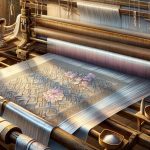Are you curious about the fascinating journey of fabric through history? Get ready to dive into the evolution of fabric, from its ancient origins to modern innovations.
Discover the incredible spinning techniques, weaving methods, and dyeing innovations that shaped the textile industry.
Uncover the global influences and trade routes that brought fabrics from distant lands.
Join us on this historical adventure as we explore the remarkable story of fabric and its impact on civilizations past and present.
Table of Contents
Ancient Origins of Textiles
You can trace the ancient origins of textiles back to the Neolithic period, when humans began weaving plant fibers into fabrics. In those early days, people used various techniques to create textiles. They employed simple tools such as hand spindles and looms to spin fibers and weave them together. These early textile techniques laid the foundation for the intricate craftsmanship we see in fabrics today.
Textiles played a significant role in religious rituals during ancient times. They were used to create sacred garments and ceremonial objects. The intricate designs and patterns woven into these textiles held deep symbolic meaning. They were believed to connect the spiritual realm with the physical world. Textiles were often used to adorn temples and sacred spaces, creating an atmosphere of reverence and devotion.
The importance of textiles in religious rituals extended beyond their decorative purposes. They were also used as offerings to deities, symbolizing the devotion and gratitude of the worshippers. The craftsmanship and quality of the textiles used in religious rituals were of utmost importance, as they were believed to reflect the devotion and respect of the worshippers towards their gods.
Spinning Techniques in Early Civilizations
Now let’s explore the fascinating world of spinning techniques in early civilizations.
You’ll learn about the ancient spinning tools that were used to create textiles, such as drop spindles and spinning wheels.
Additionally, we’ll discuss the cultural significance of textiles and how innovations in fabric production transformed societies across the globe.
Ancient Spinning Tools
The early civilizations’ spinning techniques can be traced back to their utilization of primitive spinning tools. Archaeological discoveries have revealed that ancient civilizations developed various spinning techniques to create thread and yarn. These techniques involved the use of simple tools such as drop spindles and hand spindles.
The drop spindle was a weighted object suspended from a string or stick, allowing the spinner to twist fibers into yarn by spinning the spindle and letting it drop. Hand spindles were handheld devices that were spun with one hand while the other hand controlled the supply of fiber.
These ancient spinning tools played a crucial role in transforming raw materials like wool, flax, and cotton into the fabrics that were essential for clothing, shelter, and trade in early civilizations.
Cultural Significance of Textiles
During the early civilizations, spinning techniques played a vital role in the cultural significance of textiles. These spinning techniques weren’t just a means to create fabric, but were deeply ingrained in the cultural practices of communities. Here are some ways in which spinning techniques contributed to the cultural preservation and symbolism in textiles:
-
Cultural preservation: Spinning techniques were passed down through generations, ensuring the preservation of traditional textile practices. This helped to maintain cultural identity and heritage.
-
Symbolism in textiles: Different spinning techniques were used to create unique patterns and designs on textiles. These patterns often held symbolic meanings, representing aspects of the community’s beliefs, history, or social status.
-
Expression of creativity: The artistry and skill involved in spinning techniques allowed individuals to express their creativity and personal style through the creation of textiles.
-
Economic significance: Spinning techniques weren’t only culturally significant, but also had economic implications. Communities that excelled in spinning techniques often had valuable textiles that could be traded or sold, enhancing their economic prosperity.
Innovations in Fabric Production
Spinning techniques held a significant role in early civilizations, with innovative fabric production methods shaping the development of textiles.
These early civilizations developed various spinning techniques to create fabrics from natural fibers like flax, wool, and cotton.
The invention of the spinning wheel in the Middle Ages revolutionized fabric production, increasing efficiency and output.
However, in recent years, there’s been a growing interest in sustainable fabric technologies that aim to reduce the environmental impact of fabric production.
Researchers are exploring alternative spinning techniques, such as electrospinning and nanospinning, which use less energy and produce less waste.
These sustainable fabric technologies hold great promise for the future of fabric production, allowing us to create textiles that are both eco-friendly and high-performing.
Weaving and Looms in Antiquity
In ancient times, you’d have utilized simple handheld looms to weave fabric. Weaving techniques played a significant role in ancient textile art, allowing people to create intricate patterns and designs. Here are some key aspects of weaving and looms in antiquity:
-
Handheld Looms: These looms were small and portable, making them easy to use. They consisted of a frame with vertical and horizontal threads, creating a grid-like structure for weaving.
-
Warp and Weft: Weaving involved two sets of threads: the warp and the weft. The warp threads were fixed vertically on the loom, while the weft threads were woven horizontally through them, creating the fabric.
-
Pattern Creation: Ancient weavers used various techniques to create patterns in their fabrics. This included methods like tapestry weaving, brocade, and damask, which allowed for the incorporation of intricate designs and motifs.
-
Cultural Significance: Weaving in antiquity held cultural and societal importance. It wasn’t only a means of producing clothing and textiles but also served as a form of artistic expression and a symbol of status and wealth.
Innovations in Dyeing and Printing
To embark on the historical journey of the evolution of fabric, let’s explore the advancements made in dyeing and printing. Over the years, there have been significant developments in sustainable dyeing methods and digital printing advancements, revolutionizing the way fabrics are colored and patterns are created.
In the realm of dyeing, sustainable methods have gained traction as the fashion industry seeks to reduce its environmental impact. Traditional dyeing techniques often involve the use of harmful chemicals and excessive water consumption. However, innovative approaches such as natural dyeing and low-impact dyeing have emerged. Natural dyeing utilizes plant-based materials like roots, leaves, and flowers to create beautiful and eco-friendly colors. Low-impact dyeing, on the other hand, minimizes water and chemical usage while still achieving vibrant hues.
In the field of printing, digital advancements have brought about a new era of precision and creativity. Digital printing allows for intricate designs and patterns to be directly printed onto fabric, eliminating the need for lengthy and labor-intensive processes. This technology enables fashion designers to experiment with an array of colors, textures, and motifs, resulting in unique and personalized garments.
The table below summarizes the advancements in sustainable dyeing methods and digital printing:
| Sustainable Dyeing Methods | Digital Printing Advancements |
|---|---|
| Natural dyeing | Precision and creativity |
| Low-impact dyeing | Intricate designs and patterns |
| Environmentally friendly | Personalized garments |
The innovations in dyeing and printing have not only transformed the fashion industry but have also contributed to a more sustainable and expressive way of creating fabric. As technology continues to advance, we can expect further breakthroughs that will push the boundaries of color and design.
Textile Trade Routes and Global Influences
As you delve deeper into the historical evolution of fabric, explore the profound impact of textile trade routes and global influences. The textile trade routes played a pivotal role in shaping the cultural influences and spreading the knowledge of fabric production across different regions.
-
Silk Road: The ancient Silk Road, spanning from China to the Mediterranean, facilitated the exchange of silk and other luxurious textiles, creating a cross-cultural fusion of design and techniques.
-
Indian Ocean Trade: The Indian Ocean trade routes connected Africa, Asia, and Europe, allowing for the exchange of textiles such as cotton, batik, and ikat. These fabrics became highly sought after and influenced the local textile traditions.
-
European Colonialism: European colonial powers established trade routes to exploit the resources of colonized regions. This led to the introduction of new fabric materials like wool and linen, as well as the adoption of European weaving and printing techniques.
-
Industrial Revolution: The Industrial Revolution brought mechanization to the textile industry, transforming the production and distribution of fabrics. Innovations such as the spinning jenny and power loom expanded trade routes and enabled mass production, further influencing global textile traditions.
The textile trade routes not only facilitated the exchange of physical goods but also facilitated the exchange of ideas, techniques, and designs, resulting in a rich tapestry of cultural influences in the world of fabric production.
Industrial Revolution and the Rise of Textile Factories
You’ll explore how the Industrial Revolution revolutionized fabric production with the rise of textile factories. During the late 18th and early 19th centuries, the introduction of new machinery and technologies transformed the textile industry, leading to the establishment of large-scale factories. The impact of these factories was felt not only in the realm of fabric production but also in the living conditions of textile workers and the local economies.
To give you a visual representation of the changes brought about by the Industrial Revolution, here is a table highlighting the key aspects:
| Aspects | Before Industrial Revolution | After Industrial Revolution |
|---|---|---|
| Technology | Hand-operated machines | Steam-powered machines |
| Production | Cottage industry | Mass production in factories |
| Workforce | Mostly rural artisans | Urban laborers |
The rise of textile factories had a profound effect on textile workers’ living conditions. Previously, many textile workers worked from home as part of the cottage industry. With the advent of factories, workers were forced to move to urban areas where the factories were located. These workers often lived in cramped and unsanitary conditions, facing long working hours and low wages.
However, the impact of textile factories on local economies cannot be overlooked. The concentration of factories in specific regions led to the growth of industrial towns and cities. These areas experienced significant economic development, with the creation of jobs, the growth of ancillary industries, and an increase in trade and commerce.
Modern Innovations in Fabric Technology
Now, let’s dive into the modern innovations in fabric technology and explore how these advancements have further revolutionized the production and functionality of fabrics.
-
Sustainable fabrics: With the growing concern for the environment, there’s been a surge in the development of sustainable fabrics. These fabrics are made from recycled materials, organic fibers, or utilize eco-friendly manufacturing processes. They aim to reduce the environmental impact of the textile industry by minimizing waste and energy consumption.
-
Smart textiles: The integration of technology into fabrics has given rise to smart textiles. These fabrics have embedded sensors, microchips, and conductive fibers that can interact with their surroundings. They can monitor body temperature, detect movement, and even change color or pattern in response to stimuli. Smart textiles have applications in various fields, including healthcare, sports, and fashion.
-
Improved performance: Innovations in fabric technology have led to fabrics with enhanced performance properties. For example, moisture-wicking fabrics are designed to draw sweat away from the body, keeping you dry and comfortable during physical activity. Additionally, fabrics with UV protection properties help shield the skin from harmful sun rays. These advancements have greatly improved the functionality and comfort of fabrics in everyday life.
-
Advanced manufacturing techniques: Modern fabric technology has also revolutionized the production process. Computer-controlled machines, such as laser cutters and 3D printers, allow for precise and efficient fabric cutting and production. This results in reduced waste, increased productivity, and improved quality control.
Frequently Asked Questions
How Did the Availability of Certain Raw Materials Impact the Development of Textiles in Ancient Civilizations?
The availability of raw materials greatly influenced the development of textiles in ancient civilizations. The access to different fibers like cotton, silk, and wool led to the creation of various weaving techniques and innovative fabric designs.
What Were the Social and Cultural Implications of Textile Production in Early Civilizations?
The social impact of textile production in early civilizations was significant. It brought communities together, providing a sense of identity and cultural significance. The creation of textiles also played a role in economic and social hierarchies.
How Did the Techniques of Spinning Evolve Over Time and Across Different Civilizations?
Spinning techniques evolved over time and varied across civilizations. It’s fascinating to explore the evolution of spinning techniques and how they were influenced by different cultures.
What Were the Main Differences Between Handloom Weaving and Early Mechanized Looms?
The main differences between handloom weaving and early mechanized looms were efficiency and scale. Handloom weaving required manual labor and was slower, while early mechanized looms used machines to increase production speed and volume.
How Did the Expansion of Trade Routes Affect the Spread of Textile Production and the Development of New Techniques and Styles?
The expansion of trade routes greatly impacted the spread of textile production and the development of new techniques and styles. It allowed for the exchange of ideas, materials, and technologies, leading to innovation and growth in the industry.
- Upcycling Old Clothes Into New Fashion - July 18, 2024
- Creating Custom Fabric Prints at Home - July 18, 2024
- Advanced Sewing Techniques for Home Decor - July 18, 2024





